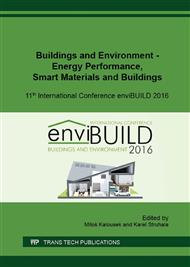p.327
p.335
p.343
p.353
p.361
p.369
p.376
p.384
p.392
Analysis of Thermal Comfort in Flat in New High Residential Building
Abstract:
This paper focuses on the analysis of thermal comfort in a flat in the new high residential building. Providing the optimal parameters of thermal comfort in each room of the flat is the basic prerequisite for the satisfaction with housing. Incorrect position and size of heating elements, incorrect positioning of the furniture and incorrect use of residential interiors may significantly disturb the thermal comfort. Residential areas in the new residential buildings are much more intensively used as in the other types of buildings. Surface of new flats is the most optimized. Experimental measurements were carried out in the winter season in 2016 in the residential rooms of the large flat in the new high residential building. Device Testo 480 with temperature and humidity sensor, globe thermometer and turbulence sensor was used for the measurements. Obtained values of air temperature, air relative humidity, air velocity, globe temperature and indexes PMV, PPD are presented in the graphs. Heating system of the flat and the possibility of its regulation, positioning and size of the heating elements in the individual rooms, positioning of the furniture and the utilization of rooms were evaluated on the basis of parameters of thermal comfort. In the conclusion of the paper, there are principles on the architectural design of the residential interiors and their heating in the new residential buildings.
Info:
Periodical:
Pages:
361-368
Citation:
Online since:
December 2016
Authors:
Price:
Сopyright:
© 2017 Trans Tech Publications Ltd. All Rights Reserved
Share:
Citation:


